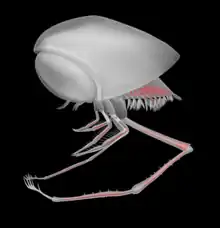Clausocaris
Clausocaris is an extinct genus of Thylacocephalan containing the single species Clausocaris lithographica from the Late Jurassic (Tithonian) aged Solnhofen Limestone in Germany.[1] It was originally named Clausia by Oppenheim in 1888, but was later changed to Clausocaris. The morphology suggests a lifestyle of a mobile or ambush oceanic predator.[2]
| Clausocaris Temporal range: | |
|---|---|
 | |
| Reconstruction of Clausocaris lithographica | |
| Scientific classification | |
| Domain: | Eukaryota |
| Kingdom: | Animalia |
| Phylum: | Arthropoda |
| Class: | †Thylacocephala |
| Order: | †Conchyliocarida |
| Genus: | †Clausocaris |
| Species: | †C. lithographica |
| Binomial name | |
| †Clausocaris lithographica Polz, 1989 | |

Clausoclaris lithographica specimen
Fossils have shown a carapace covering the bulk of its body, with compound eyes, possible gills, and also "raptorial appendages" controlled by "substantial striated muscles".[2]
References
- Clausocaris at Fossilworks.org
- Foote, Christopher (2014-08-22). "It's an eyeball with legs! Discovering more about the extinct, enigmatic and altogether bizarre Thylacocephlans". BMC Series blog. Retrieved 2019-09-21.
This article is issued from Wikipedia. The text is licensed under Creative Commons - Attribution - Sharealike. Additional terms may apply for the media files.